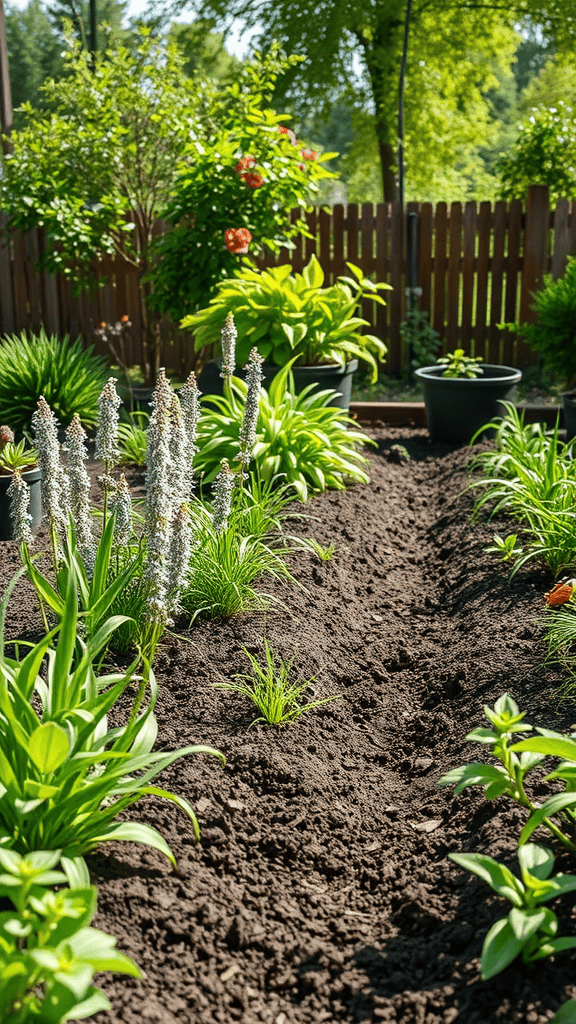Essential Gardening Steps for a Sustainable Garden
If you’re looking to create a garden that not only flourishes but also maintains the balance of nature, you’re in the right place. Establishing a sustainable garden can be both rewarding and beneficial for the environment. Here are the essential gardening steps you need to follow for a successful sustainable garden.
Choosing the Right Location
The first step is to choose the best spot for your garden. Look for a place that gets plenty of sunlight—ideally, at least six hours a day. Observe the area throughout the day to determine any patterns of shade or light. It’s also essential to consider drainage. Avoid areas where water tends to pool after rain, as this can harm your plants.
Soil Health
Healthy soil is the foundation of a sustainable garden. To improve your soil:
- Test the pH: Knowing your soil’s pH helps you understand which plants will thrive.
- Add Organic Matter: Incorporate compost, leaf mold, or well-rotted manure to enrich the soil.
- Use Mulch: Applying organic mulch can help retain moisture and suppress weeds.
Plant Selection
Choosing the right plants is crucial for sustainability. Opt for native species, which are adapted to the local climate and require less water and care. Mixing perennials and annuals can provide continuous blooms and support wildlife. Here are some tips:
- Diversity: Plant a variety of species to improve resilience against pests and diseases.
- Companion Planting: Some plants grow better together and can help deter pests naturally.
Water Management
Efficient water use is vital in sustainable gardening. Here are some strategies to consider:
- Drip Irrigation: This system delivers water directly to the roots, minimizing evaporation.
- Rain Barrels: Collect rainwater for irrigation to reduce reliance on municipal water sources.
- Deep Watering: Water deeply but less frequently to encourage deep root growth.
Pest Control
Managing pests effectively is a must for a sustainable garden. Avoid chemical pesticides and embrace natural methods:
- Encourage Beneficial Insects: Ladybugs and lacewings prey on harmful pests.
- Hand-Picking: For small infestations, hand-picking pests can be effective.
- Introduce Barriers: Use row covers or insect netting to protect your plants from pests.
Seasonal Care
Every season brings its own gardening tasks. These include:
- Spring: Prepare your soil and start planting seedlings.
- Summer: Water regularly and monitor for pests.
- Fall: Harvest your crops and prepare your garden for winter.
- Winter: Mulch to protect plants and prevent soil erosion.
Maintain Biodiversity
Promoting biodiversity is essential for a healthy ecosystem. Practices include:
- Create Habitats: Add birdhouses, bee hotels, and native plants to attract wildlife.
- Rotate Crops: Changing the location of your crops each season helps maintain soil nutrients and reduces disease.
Composting
Setting up a compost bin is an excellent way to recycle kitchen scraps and garden waste. Compost enhances soil quality and reduces the need for chemical fertilizers. Here’s how to start:
- Balance Greens and Browns: Use a mix of nitrogen-rich greens (like vegetable scraps) and carbon-rich browns (like leaves).
- Turn Your Pile: Regularly turning the compost helps aerate it and speeds up decomposition.
By following these essential gardening steps, you can create a sustainable garden that benefits you and the environment. Emphasizing natural methods and diverse plant life will lead to a thriving garden ecosystem. Enjoy the journey of nurturing your sustainable garden!
Benefits of Sustainable Gardening Practices in Urban Areas
Urban areas often face unique challenges when it comes to sustainability, especially regarding food production and environmental health. However, adopting sustainable gardening practices in these settings can yield numerous benefits that extend beyond mere aesthetics. These benefits are not just for gardeners but also for communities and the environment as a whole.
Enhancing Food Security
One of the primary advantages of sustainable gardening in urban areas is the enhancement of food security. By growing your own fruits and vegetables, you can reduce reliance on grocery stores and their sometimes questionable supply chains. This practice is particularly vital in food deserts, where access to fresh produce is limited. You can cultivate a variety of crops in small spaces, enabling you to feed yourself and your family nutritious meals directly from your garden.
Improving Air Quality
Urban environments often suffer from poor air quality due to pollution from vehicles, industry, and other sources. Sustainable gardens can help combat this issue. Plants naturally absorb carbon dioxide and release oxygen, contributing to cleaner air. Additionally, green spaces can trap dust, pollen, and other pollutants, acting as natural filters in bustling city landscapes. By creating a sustainable garden, you not only improve your immediate environment but also contribute to the overall health of your community.
Promoting Biodiversity
In the heart of bustling cities, biodiversity can take a hit, leading to an imbalance in local ecosystems. By implementing sustainable gardening methods, you can create habitats for various insects, birds, and wildlife. Here are some effective strategies:
- Plant Native Species: These plants require less water and maintenance, while providing food and shelter for local wildlife.
- Create Habitats: Incorporate features like birdhouses, insect hotels, and diverse plantings to attract beneficial species.
- Avoid Pesticides: Instead of harmful chemicals, use natural pest control methods to protect pollinators like bees and butterflies.
By promoting biodiversity, your garden can become a vibrant ecosystem that supports various forms of life.
Reducing Urban Heat
Urban areas are often significantly warmer than their rural counterparts, a phenomenon known as the urban heat island effect. Sustainable gardening can help mitigate this issue. Plants provide shade and release moisture into the air, which cools down the surrounding area. A well-planned garden can create cooler microclimates that alleviate the heat buildup associated with urban living. green roofs or vertical gardens can further enhance this cooling effect while maximizing space.
Encouraging Community Engagement
Sustainable gardening practices can foster community spirit and cooperation among residents. Community gardens, where neighbors come together to grow produce, create a sense of belonging and shared purpose. These spaces can serve as gardens for education, teaching children and adults alike about healthy eating and the environment. Engaging in gardening also provides opportunities to connect socially, share resources, and even swap gardening tips and produce.
Conserving Water
Water conservation is crucial, especially in urban settings where water supplies may be compromised. Sustainable gardening methods emphasize strategies such as:
- Rainwater Harvesting: Collect and store rainwater to use later in your garden.
- Drip Irrigation: This system delivers water directly to the roots of plants, minimizing waste.
- Mulching: Applying mulch retains soil moisture, reducing the need for frequent watering.
These practices not only help you save water but also decrease your utility bills, making your garden more eco-friendly and cost-effective.
Creating Mental Wellness Spaces
Sustainable gardens offer more than just physical benefits; they also promote mental health. Spending time in green spaces has been linked with reduced stress and improved mood. Gardening activities such as planting, weeding, and harvesting provide a sense of accomplishment and connection to nature. For urban dwellers who may feel disconnected from nature, cultivating a garden can serve as an invaluable sanctuary, fostering peace and personal wellbeing.
The benefits of sustainable gardening practices in urban areas are manifold. From enhancing food security to improving air quality, promoting biodiversity, and conserving water, these practices contribute positively not just to individual gardeners but to their entire communities. By embracing sustainable gardening, you can play a vital role in creating healthier, more resilient urban environments.
Conclusion
Embracing essential gardening steps for a sustainable garden is not just a personal journey; it’s a collective effort that carries significant benefits, especially in urban areas. With each green thumb dedicated to sustainable practices, we pave the way for healthier environments, improved air quality, and enhanced biodiversity. By selecting native plants, utilizing organic fertilizers, and managing water usage efficiently, you contribute to the local ecosystem and create a sanctuary in which both people and wildlife can thrive.
Sustainable gardening practices also promote a sense of community in urban settings. As you cultivate your garden, you are likely to inspire neighbors and friends to consider their own green spaces, leading to shared knowledge and resources. This ripple effect fosters stronger connections within communities and encourages collective action towards environmental stewardship.
Furthermore, growing your own fruits and vegetables reduces the carbon footprint associated with transporting food, which is particularly beneficial in densely populated areas. Eating from your patch of urban paradise not only provides healthier dietary options but also saves you money. The joys of harvesting your produce extend far beyond the taste; they also bring satisfaction and a sense of achievement that promotes mental well-being.
The essential steps in sustainable gardening are simple yet impactful. When you plant with intention and care for the environment, you cultivate not just gardens but legacies. By choosing to engage in sustainable practices, you can truly make a difference today for a greener tomorrow. Embrace the potential your garden holds, and watch as it flourishes, echoing the harmony of sustainable living in your urban space.

